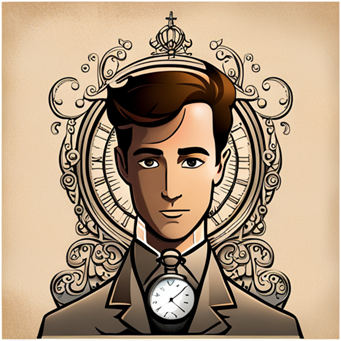The Legacy Leader: A Manager’s Journey Through Time and Generations
Student-Author: Alexis Faure (France) in the course Co-Creative Organizational Leadership – Spring 2023 #GenZ, tales from Finland collection

Once upon a time, Byron, a driven and ambitious Generation Z manager, found himself in the possession of an enigmatic antique pocket watch. Little did he know that this peculiar timepiece would propel him on a whirlwind journey through the annals of management history. As Byron examined the watch, he unwittingly set the hands in motion, and suddenly, he found himself transported back to the early 1900s. He was now in the era of Frederick Taylor’s Scientific Management.
The Age of Scientific Management
During this time, Byron observed workers performing repetitive tasks in factories, with each motion carefully measured and optimized. He learned the value of efficiency and the importance of breaking down tasks into smaller, manageable parts. As Taylor once said, “In the past, the man has been first; in the future, the system must be first” (Taylor, 1911). Just as Byron began to appreciate the intricacies of Taylor’s approach, the watch started to tick, and he was whisked away to the next era.
The Human Relations Movement
Byron found himself in the 1930s, amidst the Human Relations Movement led by Elton Mayo. He witnessed the Hawthorne Studies, in which workers’ productivity increased when they felt valued and heard. Byron realized that employee motivation was a vital aspect of effective management. As he reflected on this insight, the watch sprung to life again, moving Byron to the next period.
The Rise of Management Theory
The 1950s welcomed Byron with Peter Drucker’s Management by Objectives (MBO) and Douglas McGregor’s Theory X and Theory Y. Byron discovered that setting clear goals and understanding employees’ motivations could lead to better results. As Drucker said, “Management is doing things right; leadership is doing the right things” (Drucker, 1954). With this newfound knowledge, Byron was once again transported through time.
The Age of Innovation and Empowerment
Entering the 21st century, Byron encountered the concepts of innovation and employee empowerment. He saw how modern organizations fostered creativity and encouraged employees to take ownership of their work. Byron learned the significance of adaptability in the ever-evolving business landscape. As Byron embraced this final lesson, the antique pocket watch brought him back to his own time.
Epilogue: Lessons from the Past
Back in his office, Byron clutched the antique pocket watch, reflecting on his time-traveling journey. He understood that each era of management history had its strengths and weaknesses, but the key to exceptional leadership was combining the best aspects of each.
Byron focused on efficiency and streamlined tasks, while also prioritizing employee well-being and motivation. He set clear goals for his team and offered guidance, emphasizing innovation and adaptability in the ever-changing business landscape. By empowering his employees, Byron fostered a culture of trust and collaboration.
Under Byron’s leadership, the team thrived, becoming more productive and engaged. The blend of efficiency, empathy, clarity, and adaptability made Byron a true legacy leader, inspiring others to reach their full potential. The antique pocket watch remained a treasured reminder of the lessons learned and the journey that has taken, guiding Byron into the future. By learning from the past, Byron was well-equipped to lead his team to new heights, leaving a lasting legacy for future generations.
“Those who cannot remember the past are condemned to repeat it.” – George Santayana, 1905
Reference
Faure, A. (2023). Personal experience.